Renault CLIO 2 1.6 16V, CLIO 2 2.0 16V, CLIO 2 1.4 16V, CLIO 2, CLIO 2 1.2 16V Manual
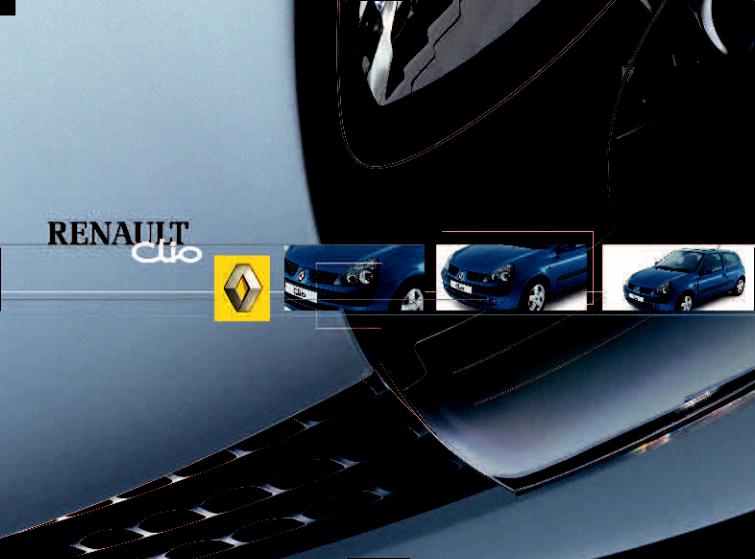

RENAULT recommends

Welcome to your new RENAULT
This driver’s handbook contains all the information you will need:
•to get to know your Renault, to use it to the best advantage and to benefit from all the latest technical developments which are incorporated in it.
•to ensure that it is always running well by following the simple, but strict, advice concerning regular maintenance.
•to enable you to deal quickly with minor faults which do not require specialist attention.
The few minutes you spend reading this handbook will be amply rewarded by the information which it provides and the technical innovations it will bring to your attention. If certain points are still unclear, the technicians in our Network will be happy to provide you with any additional information you may require.
The following symbols are used in this handbook to help you while you are reading it:
To indicate a risk, danger or safety advice.
The description of the models given in this handbook is based on the technical specifications known at the date this
document was produced. The handbook covers all equipment (standard or optional) which is available for these
models, but their presence on the vehicle depends on the version, options selected and country of marketing.
Certain equipment which is due to be made available during the year may also be included in this handbook.
Enjoy driving your new Renault.
Copying or translation, in part or in full, is forbidden without written permission from Renault, 92100 Billancourt 2002.
0.01
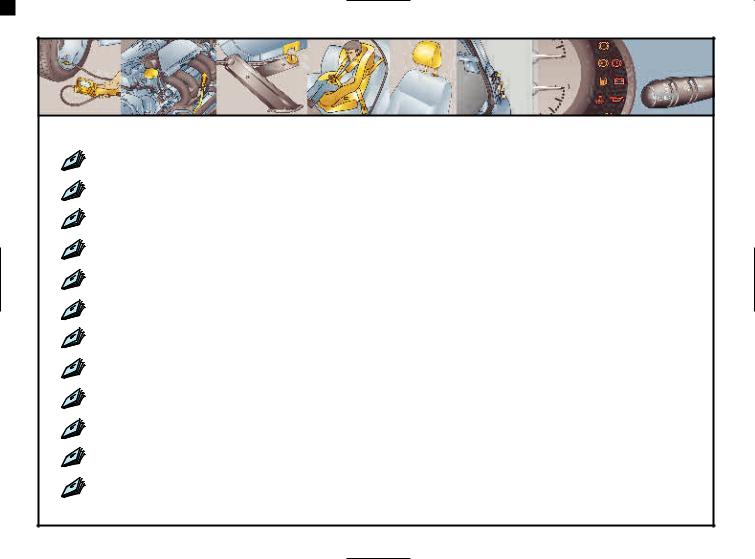
Brief overview
• Tyre pressures .............................................................................................. |
0.04 - 0.05 |
|
• Adjusting the seats and driving position ............................................... |
1.11 ¬ 1.14 |
|
• Child restraints ........................................................................................... |
1.24 |
¬ 1.36 |
• Warning lights ............................................................................................ |
1.42 |
¬ 1.52 |
• Horn and headlamp flash ............................................................. |
1.55 ¬ 1.57 - 1.62 |
|
• De-icing .................................................................................................................... |
|
1.61 |
• Running in, driving ................................................................................... |
2.02 |
¬ 2.30 |
• Heating/air conditioning ........................................................................... |
3.04 |
¬ 3.22 |
• Opening the bonnet ............................................................................................... |
|
4.02 |
• Levels (engine oil, windscreen washer, etc.) .......................................... |
4.03 ¬ 4.11 |
|
• Emergency spare wheel ............................................................................ |
5.02 |
¬ 5.05 |
• Practical advice (changing the bulbs, fuses, repairs, operating |
|
|
incidents) .................................................................................................... |
5.02 ¬ 5.34 |
|
0.02
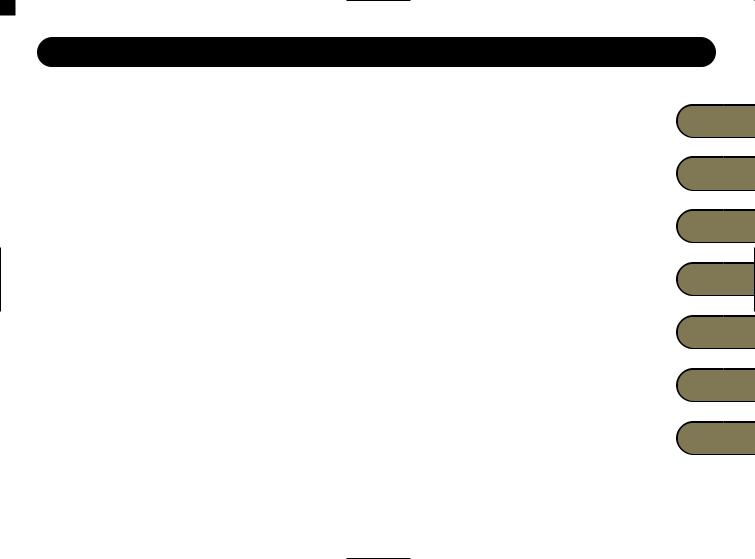
C |
O |
N |
T |
E |
N |
T |
S |
|
|
|
|
|
|
|
Sections |
Getting to know your car ..................................................................... |
|
|
|
1 |
|||
Driving |
............................................................................................................... |
|
|
|
|
|
2 |
Your comfort ................................................................................................. |
|
|
|
|
|
3 |
|
Maintenance .................................................................................................. |
|
|
|
|
|
4 |
|
Practical advice |
........................................................................................... |
|
|
|
|
5 |
|
Technical specifications |
........................................................................ |
|
|
|
6 |
||
Alphabetical index .................................................................................... |
|
|
|
|
7 |
||
0.03

Tyre inflation pressures when cold (in bar)
Versions |
1.2 |
1.4 16V |
2.0 16V |
1.5 dCi |
||
1.2 16V |
1.6 16V |
1.9 dCi |
||||
|
|
|
||||
Tyre sizes |
175/65 R14 T |
175/65 R14 T |
195/45 R16 |
195/50 R15 |
175/65 R14 T |
|
|
185/55 R15 H |
185/55 R15 H |
|
|
185/55 R15 H |
|
Normal use (2) |
|
|
|
|
|
|
• Front |
1.9 |
2.2 (1) |
2.3 |
2.3 |
2.2 |
|
• Rear |
1.8 |
2 |
2.1 |
2.1 |
2 |
|
Motorway use (2) |
|
|
|
|
|
|
• Front |
2 |
2.3 (1) |
2.7 |
2.5 |
2.3 |
|
• Rear |
2 |
2.1 (1) |
2.2 |
2.2 |
2.1 |
|
Wheel sizes |
5.5 J 14 |
7 J 16 |
7 J 16 |
5.5 J 14 |
||
6.0 J 15 |
|
|
6.0 J 15 |
|||
|
|
|
||||
Tyre safety and use of chains
Refer to the information on tyres in Section 5 for information on maintenance and, depending on the version, the conditions under which snow chains may be fitted to the vehicle.
Special features of the 2.0 16V version
The tyres on this vehicle cannot be fitted with chains. If you wish to fit snow chains, you must use special equipment. Consult your Renault Dealer.
(1)Vehicle with automatic transmission: add 0.1 bar.
(2)Special note concerning vehicles used under full load (maximum permissible all-up weight) and towing a trailer:
Maximum speed must be limited to 60 mph (100 km/h) and the tyre pressure increased by 0.2 bar (or 3 PSI). Refer to the information on weights in Section 6 for more details.
0.04
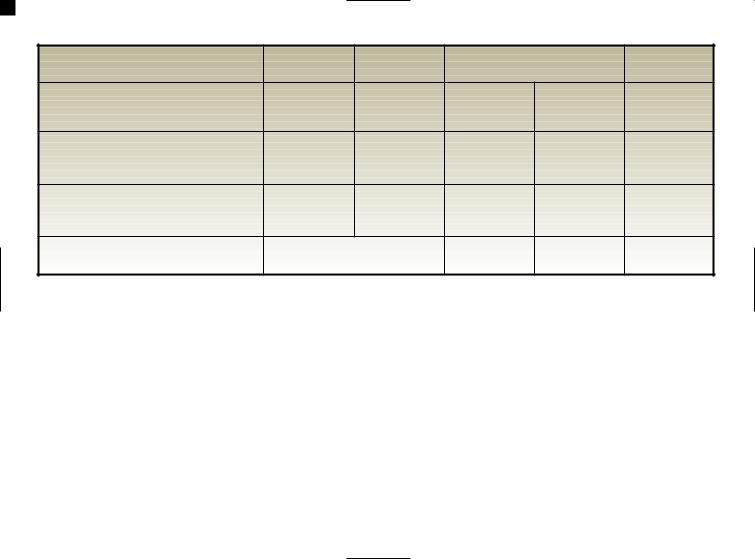
Tyre pressures when cold (in PSI) (continued)
Versions |
1.2 |
1.4 16V |
2.0 16V |
1.5 dCi |
||
1.2 16V |
1.6 16V |
1.9 dCi |
||||
|
|
|
||||
Tyre sizes |
175/65 R14 T |
175/65 R14 T |
195/45 R16 |
195/50 R15 |
175/65 R14 T |
|
|
185/55 R15 H |
185/55 R15 H |
|
|
185/55 R15 H |
|
Normal use |
|
|
|
|
|
|
• Front |
28 |
32 (1) |
33 |
33 |
32 |
|
• Rear |
26 |
29 |
30 |
30 |
29 |
|
Motorway use (2) |
|
|
|
|
|
|
• Front |
29 |
33 (1) |
39 |
36 |
33 |
|
• Rear |
28 |
30 (1) |
32 |
32 |
30 |
|
Wheel sizes |
5.5 J 14 |
7 J 16 |
7 J 16 |
5.5 J 14 |
||
6.0 J 15 |
|
|
6.0 J 15 |
|||
|
|
|
||||
Tyre safety and use of chains
Refer to the information on tyres in Section 5 for information on maintenance and, depending on the version, the conditions under which snow chains may be fitted to the vehicle.
Special features of the 2.0 16V version
The tyres on this vehicle cannot be fitted with chains. If you wish to fit snow chains, you must use special equipment. Consult your Renault Dealer.
(1)Vehicle with automatic transmission: add 3 PSI.
(2)Special note concerning vehicles used under full load (maximum permissible all-up weight) and towing a trailer:
Maximum speed must be limited to 60 mph (100 km/h) and the tyre pressure increased by 0.2 bar (or 3 PSI). Refer to the information on weights in Section 6 for more details.
0.05

0.06

Section 1: Getting to know your car
Keys - plip remote control unit ............................................................................................................ |
1.02 - 1.03 |
|
Doors ....................................................................................................................................................... |
1.04 - 1.05 |
|
Automatic locking of doors when driving ..................................................................................................... |
|
1.06 |
Engine immobiliser system ................................................................................................................... |
1.07 - 1.08 |
|
Head restraints - Seats ......................................................................................................................... |
1.09 |
¬ 1.12 |
Seat belts/Methods of restraint in addition to the front seat belts ................................................. |
1.13 |
¬ 1.23 |
Child safety ........................................................................................................................................... |
1.24 |
¬ 1.36 |
Clock and external temperature ...................................................................................................................... |
|
1.37 |
Driving position ................................................................................................................................... |
1.38 |
¬ 1.41 |
Instruments ........................................................................................................................................... |
1.42 |
¬ 1.49 |
On-board computer .......................................................................................................................... |
1.50 ¬ 1.52 |
|
Rear-view mirrors .................................................................................................................................. |
1.53 - 1.54 |
|
Steering wheel .................................................................................................................................................. |
|
1.54 |
Lighting and external signals ............................................................................................................... |
1.55 - 1.56 |
|
Headlight beam adjustment ............................................................................................................................. |
|
1.57 |
Wipers ................................................................................................................................................... |
1.58 ¬ 1.60 |
|
De-icing .............................................................................................................................................................. |
|
1.61 |
Visible and audible warning signals ............................................................................................................... |
|
1.62 |
Fuel tank (filling with fuel) .................................................................................................................. |
1.63 - 1.64 |
|
1.01
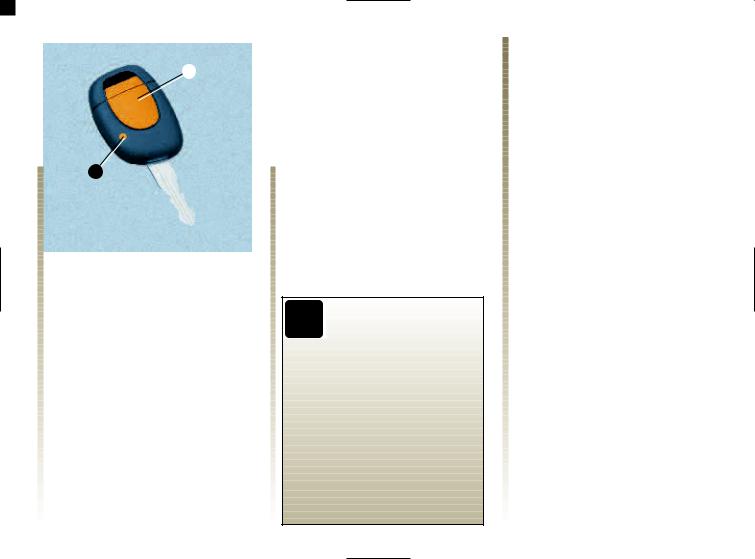
KEYS / RADIO FREQUENCY REMOTE CONTROL
|
|
|
|
|
|
|
The plip remote control 1 locks and |
|
|
|
|
|
|
|
unlocks the doors. |
|
|
|
|
|
|
||
|
|
|
1 |
|
|
|
It is supplied with power by a |
|
|
|
|
|
|
|
battery which has to be replaced |
|
|
|
|
|
|
|
when the battery tell-tale light 2 no |
|
|
|
|
|
|
|
longer comes on. (Refer to the |
|
|
|
|
|
|
|
information on the radio frequency |
|
|
|
|
|
|
|
remote control batteries.) |
|
|
|
|
|
|
||
|
|
|
|
|
|
|
|
|
|
|
|
|
|
|
|
2
1 Remote control coded ignition key, key for doors and fuel filler cap.
If there is a child (or
animal) in the car, never
leave it unattended with
the key in the ignition.
With the key in the ignition it
would be possible to operate
electrical equipment such as the
window risers and there is a risk
that the child may be seriously
injured (by trapping his or her
neck, arm, hand, etc.).
Locking/unlocking the doors
Press the remote control for approximately one second to lock or unlock the doors. (Tell-tale light 2 will switch on.)
-The hazard warning lights flash twice to indicate that the doors have been locked.
Note: Depending on the vehicle, if either a door or tailgate is open or not properly closed or if a rear interior light remains in the “continuous lighting” position (see information on interior lights in section 3), the hazard warning lights will not flash.
-The hazard warning lights flash once to indicate that the doors have been unlocked.
1.02

RADIO FREQUENCY REMOTE CONTROL (continued)
The range within which the remote control will operate
This varies according to the environment: therefore take care when handling the remote control that you do not inadvertently lock or unlock the doors.
Note: On certain vehicles, if a door is not opened within approximately 30 seconds of unlocking the door using the remote control, the doors will lock again automatically.
Interference
Interference may be caused to the operation of the remote control by factors in the immediate vicinity (external installations or the use of equipment operating on the same frequency as the remote control).
If you lose your keys or need another set of keys (or a remote control), contact your RENAULT Dealer.
•If a remote control unit is replaced, it will be necessary to take the vehicle to your RENAULT Dealer because both the vehicle and all the remote control units are needed to initialise the system.
•No more than two remote controls can be used on one vehicle.
•Make sure that the batteries are always in good condition - they last for approximately two years.
1.03
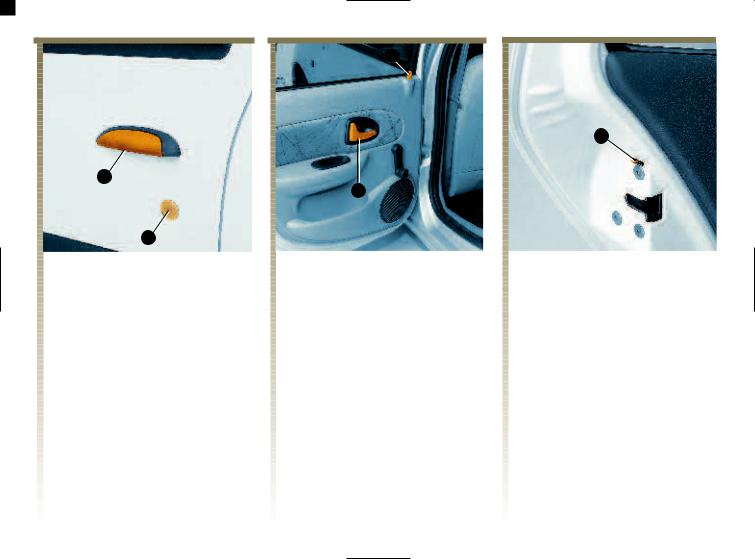
OPENING THE DOORS
1
2
Opening the doors from the outside
Front: Use the key to unlock the front door lock 2. Slip your hand under the handle 1 and pull it towards you.
Rear: When the front door is open, lift the unlocking knob 3 from inside and pull the door handle.
3
5
4
Opening the doors from inside the vehicle
Move handle 4.
Lights on warning buzzer
If you have left the lights switched on after turning off the ignition, a warning buzzer will sound when a door is opened (risk of battery discharge).
Childproof locks
To prevent the rear doors being opened from inside the vehicle, move lever 5 on each door and check from inside the car that both doors are securely locked.
1.04

LOCKING THE DOORS
1
|
|
|
|
|
|
|
Opening status warning light |
|
|
|
|
|
|
|
The warning light on switch 2 |
|
|
|
|
|
|
|
|
|
|
|
|
|
|
|
informs you of the closure status of |
|
|
|
|
|
|
|
the doors and tailgate: |
|
|
|
|
|
|
|
|
|
|
|
|
|
|
|
- the light comes on when the doors |
|
|
|
|
|
|
|
are locked; |
|
|
|
|
|
|
|
- when a door is opened (or |
|
|
|
|
|
|
|
|
|
|
|
|
|
|
|
incorrectly closed) the indicator |
|
|
|
2 |
|
|
|
light goes out. |
|
|
||||||
|
|
|
|
|
|
|
When you lock the doors using the |
plip remote control, the indicator light remains lit for approximately one minute then goes out.
Manual locking
Front: Use the key from the outside.
Rear: Press down knob 1 in each door.
Electric central locking
This enables the doors and
the luggage compartment to be locked or unlocked simultaneously.
Lock by pressing the indicator light on switch 2.
The front door mechanism cannot be locked if the door is open.
If you decide to keep the
doors locked when you
are driving, remember
that it may be more
difficult for those assisting you
to gain access to your vehicle in
the event of an emergency.
1.05

AUTOMATIC LOCKING OF DOORS, ETC. WHEN DRIVING
You must first decide if you want to activate this function.
To activate
With the ignition on, press the central door locking button 1 for approximately 5 seconds, until you hear the beep.
To deactivate
With the ignition on, press the central door locking button 1 for approximately 5 seconds, until you hear the beep.
If you decide to keep the
doors locked when you
are driving, remember
that it may be more
difficult for those assisting you
to gain access to your vehicle in
the event of an emergency.
1
Operating principle
When the vehicle moves off, the system automatically locks the doors, etc. as soon as a speed of 4 mph (6 km/h) is attained. The indicator light on button 1 light ups.
Unlocking occurs automatically:
-if a front door is opened.
Note: If a rear door is opened, this will be locked again automatically when the vehicle attains a speed of approximately 4 mph (6 km/h).
-by pressing the door unlocking button 1.
Operating incident
If you note that the system is not operating correctly (automatic locking does not take place, the indicator light on button 1 does not light up when the doors, etc. are locked), first of all check that all the doors, etc. are properly closed. However, if they are closed correctly, consult your Renault Dealer.
Also make sure that locking has not been deactivated inadvertently. If this occurs, switch the ignition off and on again and reactivate it as described above.
1.06
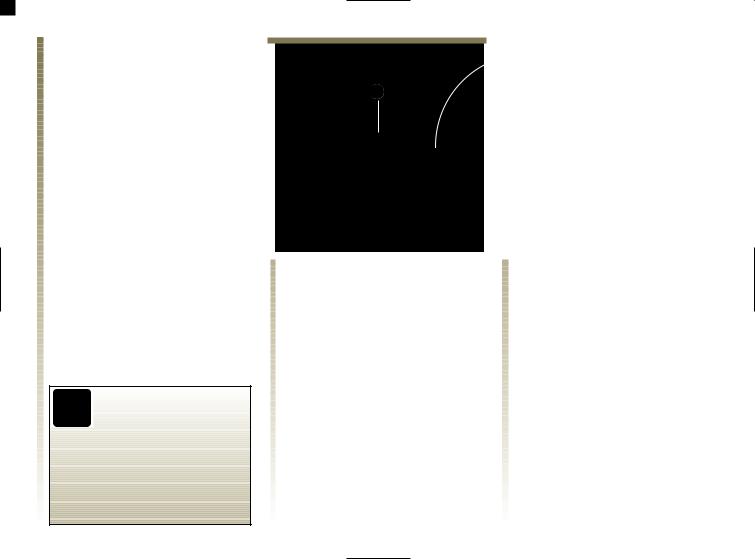
ENGINE IMMOBILISER
This prevents the engine being started by anyone who does not have the coded key for the vehicle.
|
Any |
operation |
on |
or |
|
modification |
to |
the |
|
|
immobiliser |
system |
||
|
(computers, wiring, etc.) |
|||
may be dangerous. It must be |
||||
carried |
out |
by |
qualified |
|
RENAULT personnel. |
|
|
||
1
Operating principle
The vehicle is automatically protected a few seconds after the key has been removed from the ignition.
When the ignition is switched on, warning light 1 comes on for a few seconds then goes out.
The vehicle has recognised the code and the engine may be started.
If the code of the ignition key is not recognised by the vehicle, warning light 1 will flash continuously and the engine cannot be started.
Indicator light
System operational indicator light
When the ignition is switched on, indicator light 1 lights up continuously for approximately three seconds and then goes out. You can then start the engine.
Vehicle protection indicator light
A few seconds after the ignition has been switched off, indicator light 1 will flash continuously.
The vehicle will not be protected until the key has been taken out of the ignition.
1.07
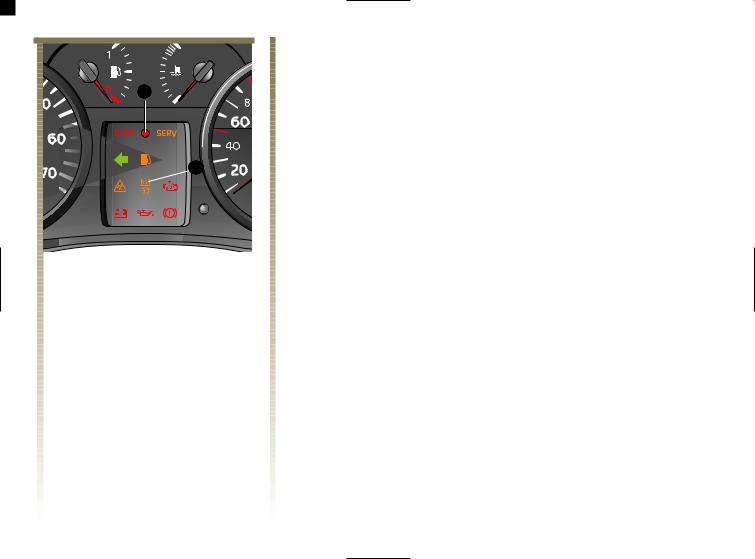
ENGINE IMMOBILISER (continued)
1
 2
2
Warning light to indicate that the system is not operating correctly
When the ignition has been switched on, if warning light 1 continues to flash or remains on, it indicates that the system is not operating correctly.
In all instances, you must contact a RENAULT Dealer, who are the only people authorised to repair the engine immobiliser system.
If the coded ignition key is faulty, use the second key (supplied with the vehicle).
1.08
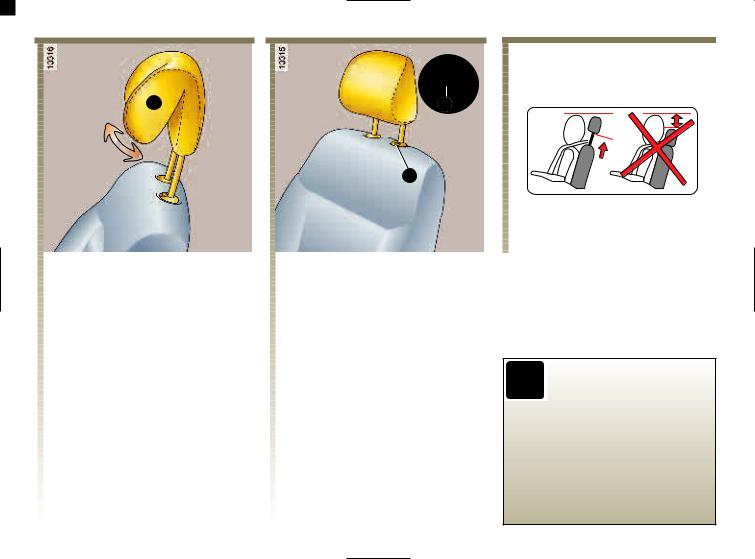
HEAD RESTRAINTS
A |
1 |
1
To raise or lower the headrest
Pull the headrest towards you (i.e. towards the front of the vehicle) and slide it up or down at the same time.
To adjust the angle of the headrest
On certain vehicles the angle of the headrest can be adjusted. To do this, move the front section A of the headrest forwards or backwards until it feels comfortable.
To remove the headrest
First incline the seatback towards the rear.
Raise the headrest until it is at the highest possible setting. Lift up tab 1 and then pull the headrest upwards until it is released.
To refit the headrest
Insert the rods into the sleeves, with the notches facing the front.
Lower the headrest until it locks in position.
The |
head |
restraint |
is |
|
important for safety: ensure |
||||
that |
it |
is |
positioned |
|
correctly. |
The |
distance |
||
between your head and the head |
||||
restraint should be as small as |
||||
possible, and the top of the head |
||||
restraint should be as close as |
||||
possible to the top of your head. |
||||
|
|
|
|
1.09 |

REAR HEAD RESTRAINTS
1
1
To adjust the height
Simply slide it up.
To remove it
Press tab 1.
To refit the headrest
Insert the rods into the sleeves, with the notches to the front, and lower the headrest to the desired height.
Storage position
When the headrest is fully lowered, it is in the storage position; do not use this position when someone is sitting in the rear seats.
The |
head |
restraint |
is |
|
important for safety: ensure |
||||
that |
it |
is |
positioned |
|
correctly. |
The |
distance |
||
between your head and the head |
||||
restraint should be as small as |
||||
possible, and the top of the head |
||||
restraint should be as close as |
||||
possible to the top of your head. |
||||
1.10

FRONT SEATS
1
2
To move forwards or backwards:
Lift lever 2 to unlock the seat. Release the lever when the seat is in the required position and ensure it is locked in place.
To raise or lower the driver’s seat:
Lift lever 1.
3
4
To tilt the seatback:
Move handle 4 and tilt the seat to the required position.
To adjust the lumbar support on the driver’s seat:
Turn wheel 3.
So that the effectiveness of
the seat belts is not
reduced, we would advise
you not to recline the
seatbacks excessively.
Make sure the seatback is locked in
place correctly.
No objects should be placed on the
floor (area in front of driver) as
such objects may slide under the
pedal during braking manoeuvres,
thus obstructing its use.
For safety reasons, adjust
the seats only when the
vehicle is stationary.
1.11

FRONT SEATS (continued)
5
6
Access to the rear seats
(three-door versions)
Lift lever 5 and slide the seat forwards.
To return the seat to its original position (memorised position) on the driver's side, slide the seat backwards until it locks.
Heated seats
With the ignition switched
on, press the switch located on the rail cover 6. An indicator light will light up on the instrument panel.
The system is not necessarily activated if the indicator light is lit up. The system has a thermostat and only operates when the passenger compartment temperature is less than 12°C (with a tolerance of plus or minus 4°C).
1.12

SEAT BELTS
Always wear your seat belt when travelling in your car. You must also comply with the local legislation in the particular country you are in.
Before driving off:
- First ensure that your driving position is correct.
- Then, to provide maximum safety, adjust your seat belt correctly.
Incorrectly adjusted seat
belts may cause injuries
in the event of an
accident.
Even pregnant women should
wear a seat belt. In this case,
ensure that the pressure of the
lap belt on the abdomen is not
excessive.
Adjusting your driving position
•Sit with your back firmly against the seatback.
This is essential to ensure your lumbar vertebrae are in the correct position.
•Adjust the distance between the seat and the pedals.
Your seat should be as far back as possible to allow you to press the clutch pedal fully down. The seatback should be adjusted so that your arms remain slightly bent.
•Adjust the position of the head restraint.
For maximum safety, your head should be as close as possible to the head restraint.
•Adjust the height of the seat.
This adjustment allows you to select the seat position which offers you the best possible vision.
•Adjust the position of the steering wheel
1
2
Adjusting the seat belts
Sit with your back firmly against the seatback.
The shoulder strap 1 should be as close to the base of the neck as possible but not on it.
The lap strap 2 should be held firmly over the thighs and against the pelvis.
The belt should be worn so that it is as close to the body as possible, i.e. avoid wearing heavy clothing or having bulky objects under the belts.
1.13
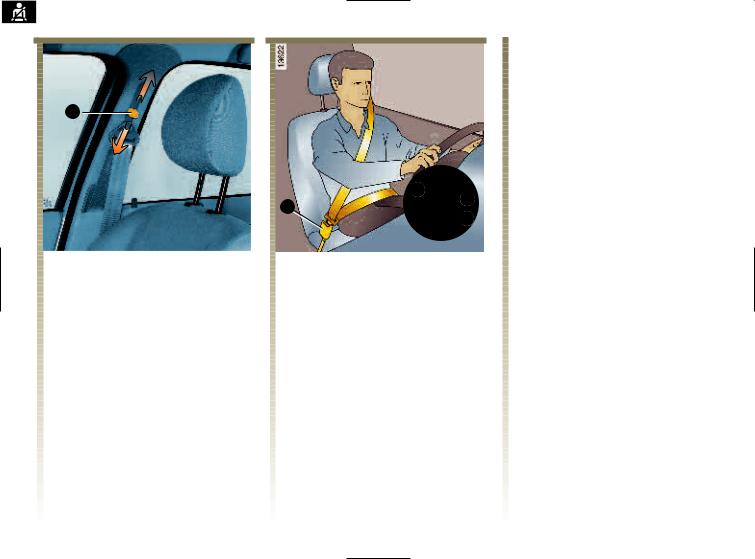
SEAT BELTS (continued)
3
Adjusting the height of the front seat shoulder strap
Move button 3 to adjust the belt so that the shoulder strap 1 is positioned as described above.
After making the adjustment, ensure the belt is correctly locked.
4
6
Locking
Unwind the belt slowly and smoothly ensuring the buckle 4 clips correctly into housing 6 (check it is locked by pulling on buckle 4). If the belt jams, allow it to return slightly before unwinding it again
Locking (continued)
If the belt is jammed completely:
-pull slowly but firmly, to unwind just over an inch (approximately 3 cm);
-allow the belt to rewind by itself;
-unwind the belt once more;
-if the problem persists, consult your RENAULT Dealer.
Driver's seat belt not fastened warning light
If the driver's seat belt is unfastened this lights up, and, when the vehicle reaches a speed of approximately 6 mph (10 km/h), it will flash and a beep will sound for approximately 90 seconds before the light returns to being permanently lit.
Unlocking
Press button 5 on housing 6. The belt will rewind by itself.
Hold the buckle to help the action.
1.14

METHODS OF RESTRAINT IN ADDITION TO THE FRONT SEAT BELTS
These are:
OFront seat belt pretensioners.
OForce limiters.
ODriver's and passenger airbags.
These airbags are adaptable in that they offer a small or large volume depending on the severity of the frontal impact.
These systems are provided to act independently or together when the vehicle is subjected to a frontal impact.
Depending on the force of the impact the system may engage:
-seat belt locking;
-the buckle pretensioner (which triggers to take up the slack in the seat belt);
-the lap belt pretensioner to keep the occupant in their seat, the low volume front airbag and the load limiters;
-the large volume front airbag.
O Side airbags are provided to activate in the event of severe side impacts.
1
Front seat belt pretensioners
With the ignition switched on, if there is a severe frontal impact and depending on the force of the impact, the system may engage:
-the piston 1 which immediately retracts the seat belt.
The pretensioners pull the seat belt against the body, holding the occupant more securely against the seat, thus increasing the seat belt's efficiency.
• Have the entire restraint system checked following
an accident.
• No operation whatsoever is permitted on any part of the
system (pretensioners, airbags, computers, wiring) and the system components must not be
re-used on any other vehicle,
even if identical.
•To avoid premature triggering of the system which may cause injury, only qualified RENAULT Network personnel may work on the pretensioner and airbag system.
•Testing of the electric trigger system may only be carried out by a specially trained technician using special equipment.
•When the vehicle is scrapped, contact your RENAULT Dealer for disposal of the pretensioner and airbag gas generators.
1.15
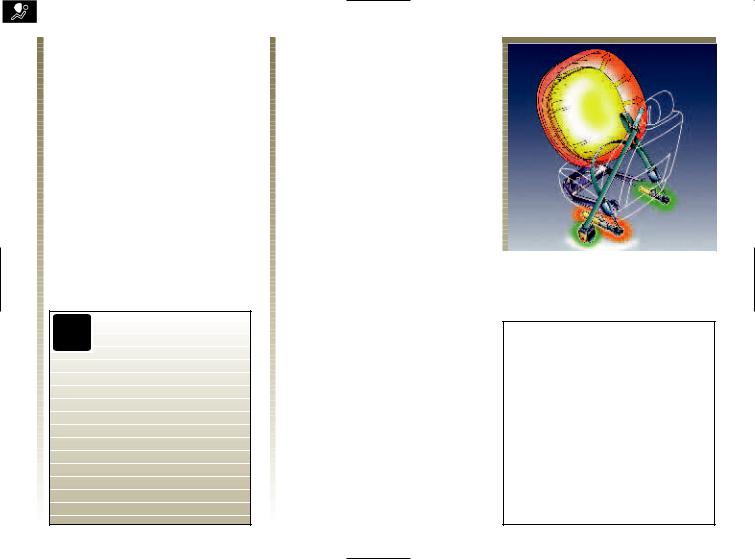
METHODS OF RESTRAINT IN ADDITION TO THE FRONT SEAT BELT (continued)
Force limiter
Above a certain severity of impact, this mechanism is used to limit the force of the belt against the body so that it is at an acceptable level.
Driver and passenger airbags
These are fitted to both the driver and the front passenger seats.
An “Airbag” marking on the steering wheel and dashboard and a label in the lower section of the windscreen inform you of the presence of additional means of restraint (airbags, pretensioners, etc.) in the passenger compartment.
Each airbag system consists of:
Warning relating to the
service life of airbags
and pretensioners
Pyrotechnic systems for
airbags and pretensioners have a
limited service life: refer to the
servicing booklet for your
vehicle for the replacement
frequency.
-an airbag and its two gas generators (for the small or large-volume bag depending on the severity of the frontal impact) mounted on the steering wheel for the driver and in the dashboard for the passenger;
-a computer for both systems, which includes the impact detector and the monitor controlling the electrical trigger system for each of the gas generators;
- A single warning light |
on |
the instrument panel. |
|
 The air bag system uses the
The air bag system uses the
 principles of pyrotechnics. This
principles of pyrotechnics. This  explains why, when the air bag
explains why, when the air bag
 inflates, it will generate heat,
inflates, it will generate heat,
 produce smoke (this does not mean
produce smoke (this does not mean
 that a fire is about to start) and
that a fire is about to start) and
 make a noise upon detonation. In a
make a noise upon detonation. In a
 situation where an air bag is
situation where an air bag is
 required, it must inflate immediately
required, it must inflate immediately
 and this may cause some minor,
and this may cause some minor,
 superficial grazing to the skin.
superficial grazing to the skin.
1.16

METHODS OF RESTRAINT IN ADDITION TO THE FRONT SEAT BELT (continued)
Operation
The system waits a few seconds after the ignition has been switched on before being operational.
If a severe frontal impact occurs, the airbag(s) inflate(s) rapidly, cushioning the impact of the driver's head and chest against the steering wheel and the front passenger's head against the dashboard. The airbag(s) then deflate(s) immediately so that the passengers are not impeded in any way when they get out of the vehicle.
The passenger airbag system is linked to a front passenger airbag deactivation warning light 2 on the instrument panel. This warning light is linked to the passenger airbag deactivation system through the ignition key.
It lights up to indicate that the passenger airbag will not be inflated in the event of an impact (refer to the section on Deactivating the front passenger airbag).
If it is still lit up after the ignition
 has been switched on again, there is 1
has been switched on again, there is 1  a fault in the system. In this case, a
a fault in the system. In this case, a  rear-facing child seat MUST NOT be
rear-facing child seat MUST NOT be
fitted to the front passenger seat.
 We do not recommend fitting any 2
We do not recommend fitting any 2  other kind of passenger seat device.
other kind of passenger seat device.
In both cases, consult your RENAULT Dealer as soon as possible.
Operational incidents
Warning light 1 lights up on the instrument panel when the ignition is turned on and then goes out after a few seconds.
If it does not light up when the ignition is turned on, there is a fault in the system.
If it lights up while you are driving, stop at once and switch off the ignition.
1.17

METHODS OF RESTRAINT IN ADDITION TO THE FRONT SEAT BELT (continued)
All the warnings below are given so that the airbag is not obstructed in any way when it is inflated and also to prevent the risk of serious injuries caused by items which may be dislodged when the airbag inflates.
The airbag is designed to complement the action of the seat belt. Both the airbags and seat belts are integral parts of the same protection system. It is therefore essential to wear the seat belt at all times. If the seat belt is not worn, it exposes the occupants to the risk of serious injury in the event of an accident. It may also increase the risk of minor, superficial injuries occurring when the airbag is deployed, although such minor injuries are always
possible with airbags.
The airbag does not offer protection against minor and moderately serious frontal impacts, side or rear impacts or if the
vehicle turns over.
Airbags for driver and passenger
•No work or modification whatsoever may be performed on the entire airbag system for the driver and passenger (computer, wiring, etc.) except by qualified RENAULT network personnel.
•To ensure that the system is in good working order and to avoid incorrect triggering of the system which may cause injury, only qualified RENAULT network personnel may work on the airbag system.
•As a safety precaution, have the airbag system checked if your vehicle has been involved in an accident, is stolen or broken into.
•When selling or lending the vehicle, inform the user of these points and hand over this handbook with the vehicle.
•When scrapping your vehicle, contact your RENAULT Dealer for disposal of the gas generator(s).
1.18

METHODS OF RESTRAINT IN ADDITION TO THE FRONT SEAT BELT (continued)
1
All the warnings given below are designed to ensure that the airbag can inflate correctly and to prevent serious injuries caused by items which may be dislodged when the airbag inflates.
Warnings concerning the driver’s airbag
• Do not adjust either the steering wheel or the airbag cushion.
•Do not cover the airbag cushion.
•Do not attach any objects (badge, logo, clock, telephone holder, etc.) to the airbag cushion.
•The steering wheel must not be removed (except by qualified personnel from the RENAULT network).
•Do not sit too close to the steering wheel. If you sit with your arms slightly bent (see the information on Adjusting your driving position in Section 1), you will ensure that there is sufficient space for the airbag to inflate properly and to be fully effective.
Warnings concerning the passenger airbag: location 1
•Do not attach or glue any objects (badges, logo, clock, telephone holder, etc.) onto the front passenger side of the dashboard.
•Nothing should be placed between the dashboard and the passenger (pet, umbrella, walking stick, parcels, etc.).
•The passenger must not put his or her feet on the dashboard or seat as there is a risk that serious injuries may be sustained. As a general rule, keep all parts of the body (knees, hands, head, etc.) well away from the dashboard.
•You should reactivate the airbag as soon as you remove the child seat from the front passenger seat to ensure the protection of the front passenger in the event of an impact.
IT IS FORBIDDEN TO FIT A REAR-FACING CHILD SEAT ON THE FRONT PASSENGER SEAT WHILE THE RESTRAINING METHODS ADDITIONAL
TO THE PASSENGER SEAT BELT ARE NOT DEACTIVATED.
(Refer to the information on Deactivation of front passenger airbags in Section 1).
1.19

METHODS OF RESTRAINT IN ADDITION TO THE FRONT SEAT BELT (continued)
Side airbags |
|
|
|
|
|
|
Warnings concerning the |
|||
These airbags may be fitted to the |
|
|
|
|
|
|
||||
|
|
|
|
|
|
side airbag |
|
|
||
front seats and are deployed at the |
|
|
|
|
|
|
|
|
||
|
|
|
|
|
|
• Fitting seat covers: Seats |
||||
sides of the seats (door side) to |
|
|
|
|
|
|
||||
|
|
|
|
|
|
equipped with an airbag |
||||
protect the occupants in the event of |
|
|
|
|
|
|
||||
|
|
|
|
|
require |
special |
covers |
|||
a severe side impact. |
|
|
|
|
|
|||||
|
|
|
|
|
specifically |
designed for your |
||||
|
|
|
|
|
|
|||||
|
|
|
|
|
|
vehicle. Consult your RENAULT |
||||
|
|
|
|
|
|
Dealer to see if appropriate |
||||
|
|
|
|
|
|
covers are |
available |
from |
||
|
|
|
|
|
|
RENAULT outlets. The use of any |
||||
|
|
|
|
|
|
covers other than those designed |
||||
|
|
|
|
|
|
for your vehicle (and including |
||||
|
|
|
|
|
|
those |
designed |
for |
another |
|
|
|
|
|
|
|
vehicle) may affect the operation |
||||
|
|
|
|
|
|
of these airbags and reduce your |
||||
|
|
|
|
|
|
protection. |
|
|
|
|
|
|
|
|
|
|
• Do not place any accessories, |
||||
|
|
|
|
|
|
objects or pets between the |
||||
|
|
|
|
|
|
seatback and the door. This may |
||||
|
|
|
|
|
|
prevent the airbag from operating |
||||
|
|
|
|
|
|
correctly or cause injury if the |
||||
|
|
|
|
|
|
airbag is deployed. |
|
|
||
|
|
|
|
|
|
• No |
work |
or |
modification |
|
The |
slits |
on |
the |
front |
whatsoever may be carried out |
|||||
seatbacks |
(door |
side) |
and |
on the seat, except by qualified |
||||||
the |
gap |
between the |
rear |
RENAULT Network personnel. |
||||||
bench |
seatback |
and |
the |
|
|
|
|
|
||
interior fittings form the trigger |
|
|
|
|
|
|||||
area for the airbag, so it is |
|
|
|
|
|
|||||
forbidden to place any objects |
|
|
|
|
|
|||||
there. |
|
|
|
|
|
|
|
|
|
|
1.20

METHODS OF RESTRAINT IN ADDITION TO THE REAR SEAT BELTS
Force limiter
In the event of a frontal impact above a certain severity, this mechanism is used to limit the force of the belt against the body so that it is at an acceptable level.
Rear side seat belt pretensioners
This system is only operational when the ignition is switched on.
If the vehicle is subjected to a severe impact, a device retracts the seat belt, pulling the seat belt tight against the body and thereby improving its efficiency.
Warning relating to the
service life of airbags and
pretensioners
Pyrotechnic systems for
airbags and pretensioners have a
limited service life: refer to the
servicing booklet for your vehicle
for the replacement frequency.
1.21
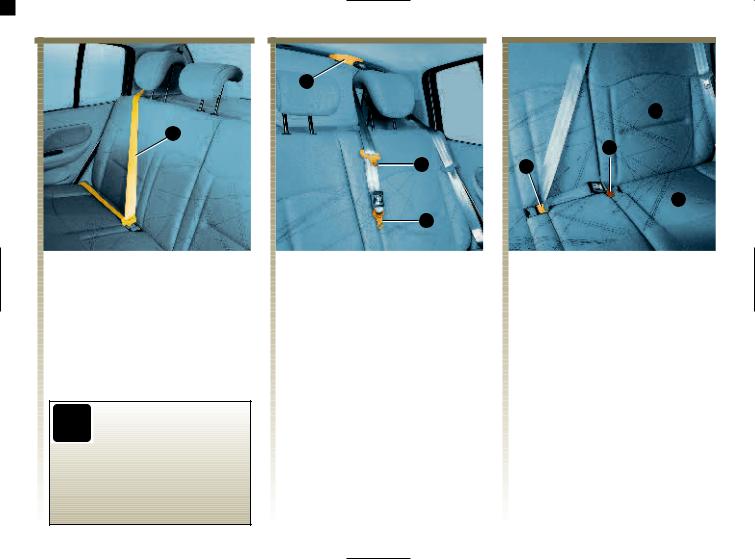
REAR SEAT BELTS
1
Rear side seat belts 1
The belts are locked, unlocked and adjusted in the same way as for the front seat belts.
The rear bench seat must
be correctly secured for
the seat belts to be
efficient.
Refer to the information on rear
bench seats in section 3.
2
4
Rear central belt
Unwind the belt slowly from position 2.
Fasten the black buckle 4 into the black housing 6.
Fasten the last sliding buckle 2 into the red housing 5.
A
6
5
B
Special point concerning vehicles with a two-part rear bench seat
If you have to fold down the part of the rear bench seat behind the front left-hand seat:
-lift the cushion B against the front seat;
-insert the black buckle 4 into the black housing 6;
-lower the seatback A (after removing the head restraint).
Then fasten the last sliding buckle 3 into the red housing 5.
1.22
